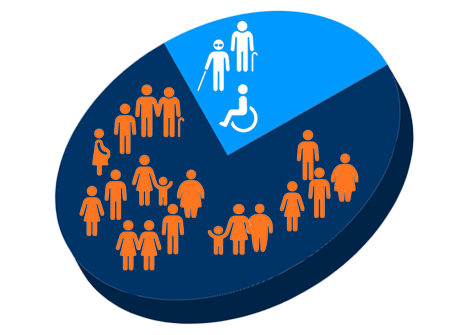
Market share expansion
One of the largest areas for growth for businesses is expansion into new or underserved markets. Organizations spend time and money researching new opportunities and marketing to them. But what if there is a market share folded into every vertical that you’re already serving? People with disabilities fall into every sector of the public. Be sure you’re not excluding this enormous market share by having inaccessible digital content. Exploring disability statistics shows the importance of this sector.
Large sectors report disabilities
According to the World Health Organization (WHO), 15% of people worldwide (1 billion people) have a disability. The Centers for Diseases Control (CDC) claims that number is about 25% of people in the U.S. (61 million adults). But how do these disability statistics impact your business?
Significant spending power for PWD
People with disabilities (PWD) control $544 billion in disposable income in the U.S., according to a 2016 study. If you add in friends and family of PWD, that spending power jumps up to $8 trillion globally. These numbers are comparable with the African American ($501 billion) and Hispanic ($582 billion) market segments. A 2018 article in Disability Magazine, estimates that discretionary income for working-age people with disabilities is about $21 billion. This is greater than that of the African-American ($3 billion) and Hispanic ($16 billion) market segments combined. This is not an insignificant market share.
Over 95% of websites contain accessibility errors
Many organizations examine disability statistics. A 2021 study called the WebAim Million found that 96.8% of website home pages contained Web Content Accessibility Guidelines (WCAG 2.0) failures. (WCAG is a set of parameters for measuring digital accessibility. You can learn more about it on this Equidox Resources page.) Most detected errors fell into these categories: poor color contrast text, missing alternative text for images, unidentified links, missing form input labels, unidentified buttons, and failure to identify document language.
These common errors do not require in-depth web expertise to rectify. Choose an easy-to-use tool for web and document remediation so that all content creators can maintain accessibility for the content they create. This includes marketing, finance, human resources, IT, or any other department.
Digital accessibility compliance is a legal requirement

One of the biggest disability statistics is the number of lawsuits. In 2021 there were 4,055 digital accessibility lawsuits. In 2020, the DoJ issued 265,000 Title III Americans with Disabilities Act (ADA) demand letters to U.S. businesses. These included both digital accessibility and physical access demands. Resolution of these demands typically involves a financial settlement and/or modifications to bring company websites into compliance with WCAG. Additionally, courts often award financial settlements in addition to remediation demands. Settlements stave off lawsuits that could drag on for years and result in even higher financial penalties for the defendant.
Recently the Department of Justice (DoJ )has announced its intention to increase enforcement of Section 508 of the Rehabilitation Act. Section 508 applies to state and federal agencies. It also covers businesses that sell products and services to the federal government or its contractors, and organizations that receive federal funding. Recent guidance from the DoJ affirms that the ADA covers enterprise corporate websites, not just government websites. This guidance also recommends using WCAG as the standard for checking that your digital information is accessible. What this means for businesses is that the DoJ is on the lookout for noncompliance and actively pursuing complaints. The best defense is to proactively remediate your website and digital documents using WCAG.
Don’t forget about your digital documents
Digital documents need to be accessible, too. PDFs are particularly notorious for being inaccessible. In a 2015 survey of assistive technology users, 41% of assistive technology users estimated that “more than half of all the PDFs they read had not been tagged correctly.” They reported very similar errors to those found in the WebAim Million report. And they reported issues with incomprehensible tables and improper reading order of page elements. 62% of the assistive technology users reported reading PDF documents every day, with 86% of them interacting with PDFs at work. This blog article, A 7-Step plan to remediate PDFs on your website, may be helpful in addressing a large backlog of PDF documents.
Find the right tools
Finding the right tools makes digital accessibility compliance much faster and easier for those responsible in your organization. Reduce the strain on your accessibility team by choosing a tool anyone can use. If you don’t have an accessibility team, having a tool that is easy to learn and use makes a big difference in terms of cost, time, and staffing requirements. Equidox PDF Accessibility software is designed with this in mind. Most users learn the software very quickly. With such a tool, organizations can make all content creators responsible for the accessibility of their own content. Using Equidox, newly published content is already accessible, and complaints and lawsuits are averted. Try Equidox for free.
Tammy Albee
Tammy Albee | Director of Marketing | Equidox Tammy joined Equidox after four years of experience working at the National Federation of the Blind. She firmly maintains that accessibility is about reaching everyone, regardless of ability, and boosting your market share in the process. "Nobody should be barred from accessing information. It's what drives our modern society."
Let’s talk!
Speak with an expert to learn how Equidox solutions make PDF accessibility easy.
